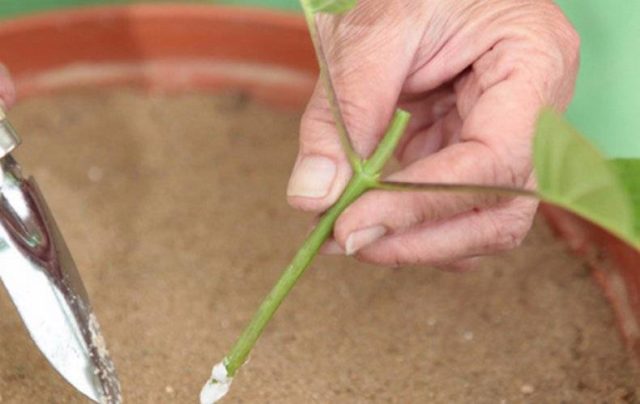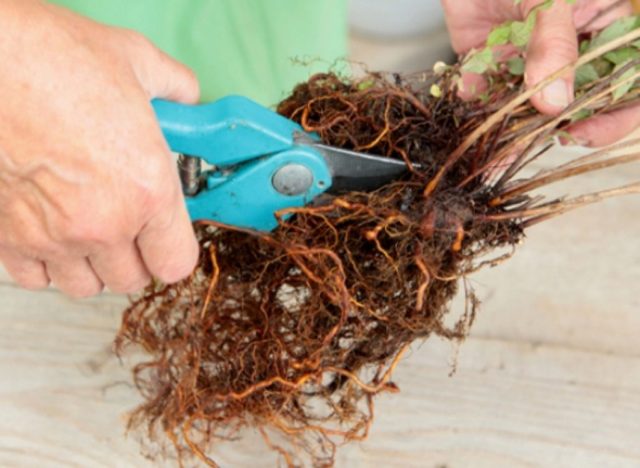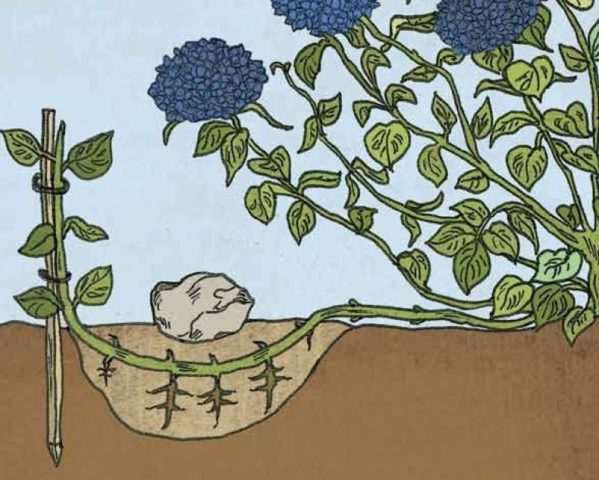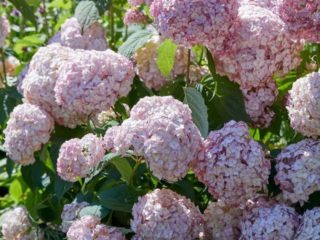Content
Hydrangeas have long attracted florists and garden design enthusiasts for their beauty and abundant flowering. Thanks to intensive work, to date, breeders have bred hundreds of varieties of this plant of the most varied colors. Among them, the red hydrangea stands out - a real highlight of the personal plot, which looks very impressive both in single plantings and as part of flower arrangements.
Description of fiery red hydrangea
Large-leaved hydrangeas with bright red inflorescences are a perennial deciduous shrub with long, strong shoots of medium thickness. Its height can reach, depending on the variety, up to 1.5-1.8 m. Shoots are densely covered with large, dense dark green oval-elongated leaves, with a serrated edge, the leaf plate is slightly curved by a boat. Large-leaved hydrangeas usually bloom on the shoots of the last year, from July to September, although there are remontant varieties, which also bloom on annual shoots. Garden red hydrangea - in the photo below:
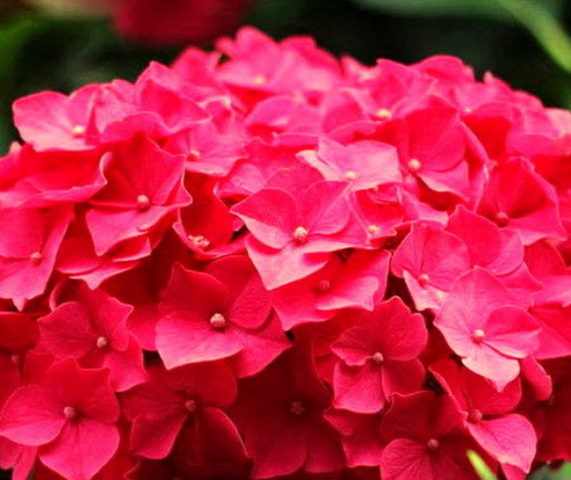
The flowers of hydrangeas are collected in large spherical inflorescences-shields with a diameter of up to 0.3 m
The flowers of the large-leaved hydrangea are rather large, consist of flat petals of various shades, including bright red. This factor largely depends on the acidity of the soil on which the plant is grown.
Red hydrangea varieties
The bright red color always attracts increased attention. Therefore, hydrangeas with inflorescences of this color are consistently popular with flower growers. However, there are not so many varieties with pure red flowers, and most of them belong to the large-leaved species.
Alpengluhen
It is one of the most decorative varieties of large-leaved hydrangea with red flowers. The shrub 1-1.2 m high consists of straight, medium-thick shoots. The foliage is high. The leaves are simple, bright green, large.
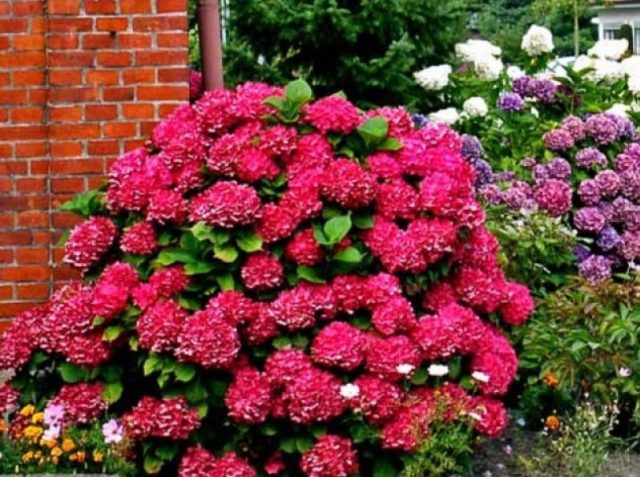
Hydrangea bloom begins in late June and ends in early autumn.
Red flowers appear on last year's shoots. Inflorescences are cap-shaped, large, up to 25 cm in diameter. The plant requires abundant watering and compulsory shelter for the winter.
Hot Red
An adult bush of this variety of large-leaved hydrangea reaches a height of 1 m and the same diameter. Its shape resembles a ball because of the straight central stems and arcuate lateral shoots. The leaves are large, dark green.
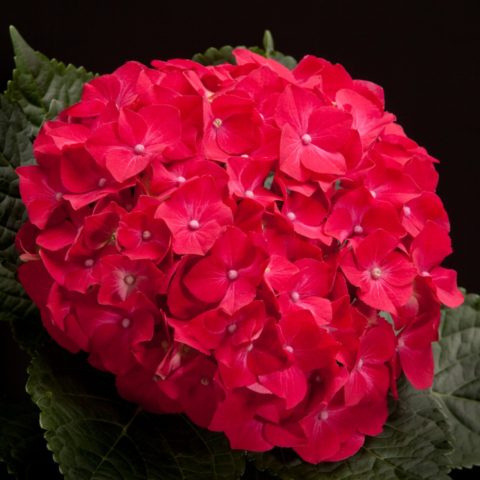
Large-leaved hydrangea Hot Red blooms on last year's shoots
Red inflorescences are medium in size, spherical, reaching 15 cm in circumference. Flowering begins in the second half of June and lasts until autumn.
Red Angel
The bush of this variety of red large-leaved hydrangea, when grown outdoors, can grow up to 1.5 m. It appeared relatively recently - in 2015, but quickly gained popularity.Differs in smooth erect shoots and dark green leaves with a characteristic purple tint.
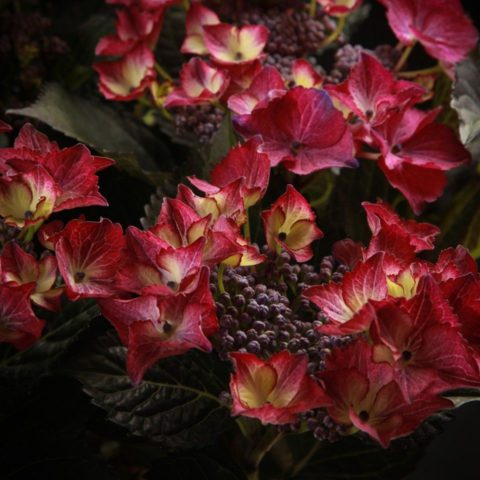
Flowering begins in July and ends in late summer.
The change from the initially yellow color of the petals to red occurs gradually, because of this, the inflorescences of the Red Angel hydrangea look a little variegated. They can be up to 20 cm in diameter.
Red Baron
This is one of the varieties of large-leaved red hydrangea, widely used not only for cultivation in the open field, but also in containers. In this form, flowering bushes are used to decorate halls, halls, foyers, as well as to decorate household plots without transplanting into open ground. The average height of an adult bush in a potted growing method is 0.5-0.6 m, in the open field - about 1 m, sometimes a little more.
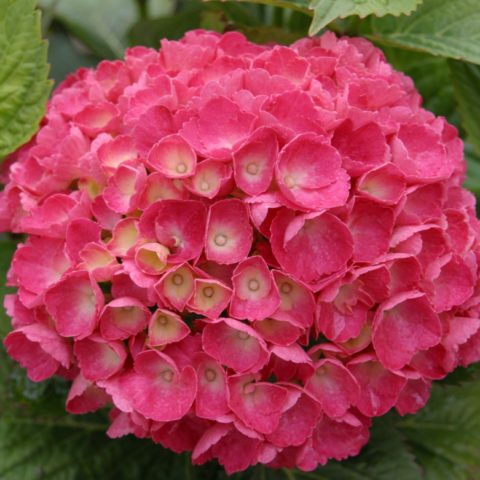
Large-leaved hydrangeas Red Baron bloom from July to September
Inflorescence caps are large, up to 25 cm in diameter. The flowers are pinkish-crimson with a pale green center. Coloring strongly depends on the acidity of the soil on which the flower is grown.
Red Sensation
This variety of red large-leaved hydrangea is a compact shrub up to 1 m high. The shoots are even, erect, strongly leafy. Grown as a tub plant, in warm regions it is also planted in open ground.
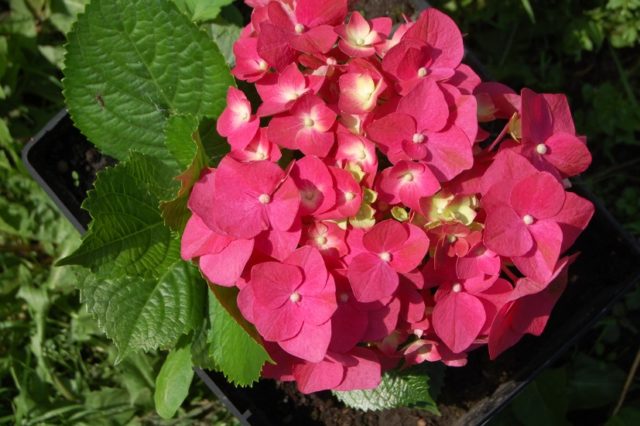
Blooms from July to early September
Inflorescences are cap-shaped, up to 20 cm in diameter. Their color over time changes from pinkish-green to ruby, and closer to autumn, purple tones with a shade of beetroot appear in it.
Red hydrangea in landscape design
In landscaping, hydrangeas with such brightly colored buds can be used for a variety of purposes. Due to the fact that red attracts attention, it can be different color accents, mixborders in combination with hydrangeas of a different color, low borders and hedges.
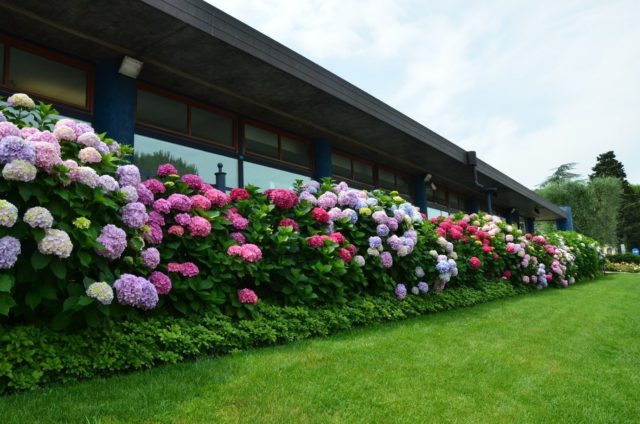
The multicolored hydrangea border looks great
Very often they are planted near the entrance to the building or along its walls. A red hydrangea in the center of a well-groomed lawn will look beautiful. Low bushes are often planted in flowerpots next to architectural objects and statues on pedestals.
Winter hardiness of hydrangea with red flowers
Unfortunately, large-leaved varieties of red hydrangeas are not only the most decorative, but also the most thermophilic. According to the international classification, they belong to the plants of the 6th climatic zone with frost resistance not lower than - 23 ° С. For central Russia, which lies in the 4th climatic zone, this is clearly not enough. Therefore, in this region, it is recommended to grow large-leaved hydrangeas only as tub plants, removing them for wintering indoors. If you plant them in open ground, then this requires mandatory shelter for the winter, but even in this case, a favorable outcome is not guaranteed.
Planting and caring for red hydrangea
The main activities for planting and caring for red hydrangeas are not difficult. For outdoor cultivation, choosing the right planting site is of great importance. In addition, plants will need regular watering, feeding, and a little pruning. If the shrub remains in place for the winter, then it must be covered, otherwise it will die or not bloom.
Selection and preparation of the landing site
Red large-leaved hydrangeas love light, but they must be protected from direct sunlight.In the southern regions, it is allowed to plant these plants in partial shade, however, the further north, the more illuminated the area should be. The shrub does not like the cold north wind, so you need to choose a protected place for it. The soil should be light and breathable, well drained. Hydrangeas are very fond of moisture, but too much of it can destroy them. They should not be planted in an area with a high level of groundwater, on saline soils, in places where water stagnates after rains or melting snow.
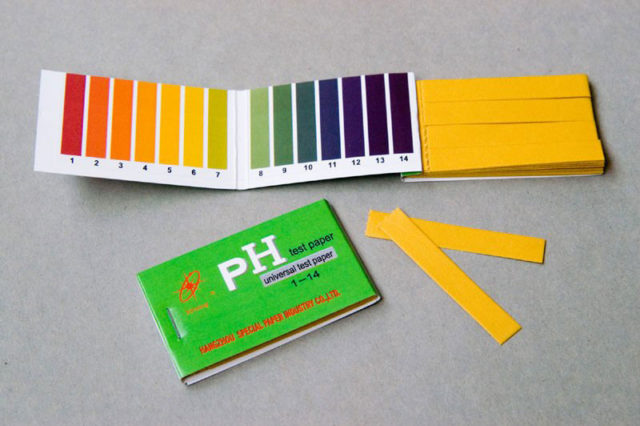
The acidity of the soil is of great importance, you can check it with the help of litmus tests
How to plant a red hydrangea
Seedlings of red large-leaved hydrangea varieties are usually sold in containers. It is best to replant them in open ground in early spring, before the plant begins to grow, and in autumn. Having decided on the landing site, it is necessary to dig a landing hole in advance. Roughly, its dimensions should be 0.5 m in diameter and 0.4 m in depth, but it is more expedient to determine this indicator based on the size of the container in which the hydrangea root system is located.
The soil mixture should also be prepared in advance, which will fill the planting hole after planting the seedling. The best option would be to mix the removed soil with humus in a 1: 1 ratio, and also add 0.5 parts of sand and peat to the mixture. To increase the acidity, dry needles can be added to the soil. Be sure to equip drainage. To do this, a layer of coarse pebbles or expanded clay should be poured onto the bottom of the pit.
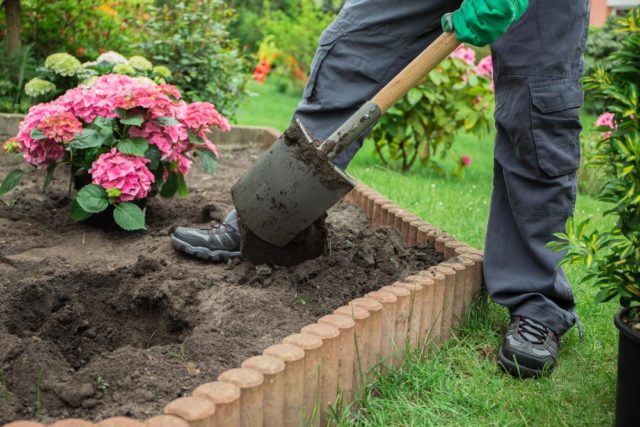
The planting pit must be guaranteed to contain the root system of the flower
Before removing the seedling from the container, spill it with plenty of water in advance. It is not necessary to shake the earth from the roots. The seedling is installed vertically in the planting pit so that its root collar is flush with the ground. If necessary, you can add a little soil to the pit. Having installed the seedling at the desired height, the hole is completely filled with soil mixture, compacted, watered abundantly, and then the root zone is mulched with the bark of coniferous trees.
Watering and feeding
The Latin name for hydrangea is Hydrangea, literally translated as "a vessel of water." Indeed, it is a very moisture-loving plant. However, excessive watering can only harm him. In conditions of insufficient natural humidity and lack of precipitation, hydrangeas are watered at least 1 time per week at the rate of 1 bucket for each adult bush. During the flowering period, this figure can be doubled. For irrigation, you need to use only rainwater, since artesian and tap water often have increased hardness, and this reduces the acidity of the soil.
To feed red hydrangeas, you can use special prolonged-release fertilizers (Fertika, Pocon, etc.). They are sold in specialized florist shops.

Using specialized fertilizers is more convenient
You can also use conventional organic and mineral fertilizers. Such dressings are introduced several times per season, using the root method, according to the following schedule:
- Early spring - urea, water solution, 30-35 g per 1 sq. m.
- Budding phase - superphosphate + potassium salt, aqueous solution, 20-30 g of each of the components per 1 sq. m.
- 15 and 30 days after the previous feeding - the same composition.
- After flowering - humus or rotted manure, 10-15 kg for each bush.
Pruning hydrangea with red flowers
As a rule, red large-leaved hydrangeas are rarely pruned. This procedure can be used as a sanitary procedure to remove broken or dried shoots. In addition, to rejuvenate the bush, it is recommended to cut off all shoots at a distance of 35-40 cm from the ground once every 4 years. Some old shoots can be removed at the root in case of strong thickening of the bush. Hydrangeas are pruned in early spring, before the start of the growing season.
Preparing for winter
The easiest way to winterize hydrangeas that grow in containers, they just need to be taken to a storage room. If the plant is planted in open ground and it is supposed to winter in the same place, then the preparation must be thorough. It is easiest to prepare low bushes for winter, they can simply be covered with earth, and then sprinkled with fallen leaves, additionally covered with lutrasil on top.
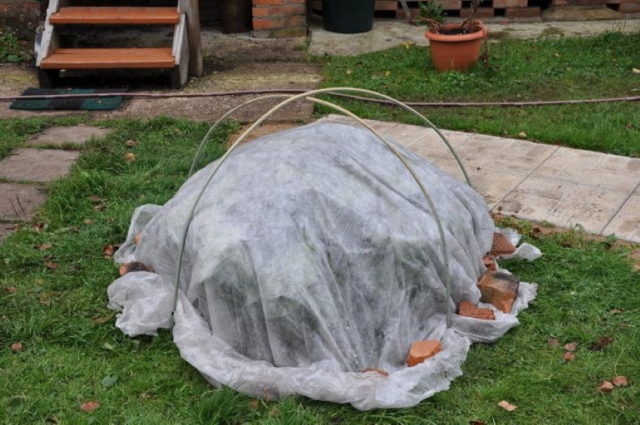
Shelter of hydrangeas for the winter is mandatory for areas with an unfavorable climate.
Older bushes need more serious cover. Usually, in adult plants, shoots are tied in several bundles, and then they are bent to the ground in different directions from the center, with an "asterisk", having previously placed a thick layer of spruce branches under each of them. After that, they are fixed in this position. Then a layer of dry leaves is poured on top, spruce branches are laid, and covering material is pulled over it.
Reproduction
Red large-leaved hydrangeas can be propagated in any vegetative way:
- Cuttings. It is best to use green cuttings taken from annual shoots in mid-summer to propagate hydrangeas. They are planted in water or in a special substrate, and after the formation of the root system, they are transplanted into individual containers for growing.
Green hydrangea cuttings root quite well
- Division of the bush. In early spring and after flowering, mature bushes of large-leaved red hydrangeas can be divided into parts. To do this, they are dug out of the ground and cut or broken into several divisions, while each of them must have shoots with roots. After dividing, part of the bush must be immediately rooted in a new place.
Dividing a bush is not only a method for propagating hydrangea, but also a way to rejuvenate a flower.
- Layers from the mother bush. In the spring, one of the flexible side shoots is bent to the ground and covered with soil. With regular moistening, the buried cuttings will begin to form their own root system. After wintering, it is cut off, carefully dug out of the ground and transplanted to a new place.
A simple way to propagate hydrangeas is air layering
Hydrangeas can be propagated by seed, but the process is time consuming. Therefore, it is usually used for scientific purposes, and growers prefer faster and more reliable vegetative methods.
Diseases and pests
Large-leaved red hydrangeas have good immunity to diseases. They get sick mainly due to improper planting or care, as well as when grown in adverse weather conditions. The most common disease in hydrangeas is chlorosis. It manifests itself in a change in the color of the leaves, which become pale green, while the veins on them remain dark, clearly distinguishable. Chlorosis is caused by a lack of iron in the soil or the plant's inability to assimilate it due to too strong alkalization of the soil.

Pale color of the leaf plate is a sign of chlorosis
You can quickly get rid of chlorosis by spraying the bushes with iron sulfate. To avoid this disease, it is necessary to prevent too much decrease in the acidity of the soil, and for prevention it is recommended to introduce preparations containing iron chelate into the soil, for example, Antichlorosis.
Violations of care and adverse weather conditions can provoke the development of fungal diseases on hydrangeas.
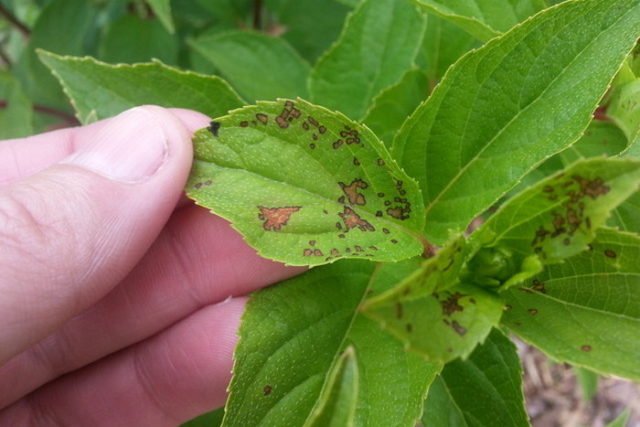
Blackening of the leaves may indicate a fungal infection of the hydrangea.
When various spots, putrefactive deposits, mold appear on the leaves, it is necessary to remove the affected parts of the plants, and treat the bushes and neighboring plantings with fungicides.
The appearance of pests on large-leaved hydrangeas can also be associated with disturbances in care. One of the common types of insects found on these shrubs is the aphid. Large accumulations of the pest can significantly weaken the plant. In this case, it is better to treat the shrubs with insecticides.
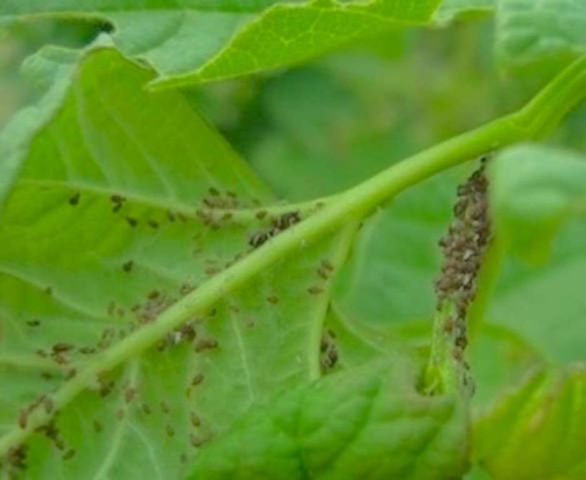
Aphids usually hide on the back of the leaves.
If the aphid colonies are small, they can simply be washed off with water or soapy water.
Another pest that is quite common on hydrangeas is the spider mite. It is a microscopic sucking insect that feeds on the sap of young shoots. You can find it by the thin cobwebs that entangle the tops of the shoots.

Cobweb nests indicate the appearance of a spider mite
To combat spider mites, special means are used - acaricides.
Conclusion
Red hydrangea is very decorative and looks great in the garden. In many regions, it can be grown outdoors, be sure to cover it for the winter. However, growing in containers in areas with unfavorable climates looks more promising, especially in the presence of a room adapted for the wintering of hydrangeas.
